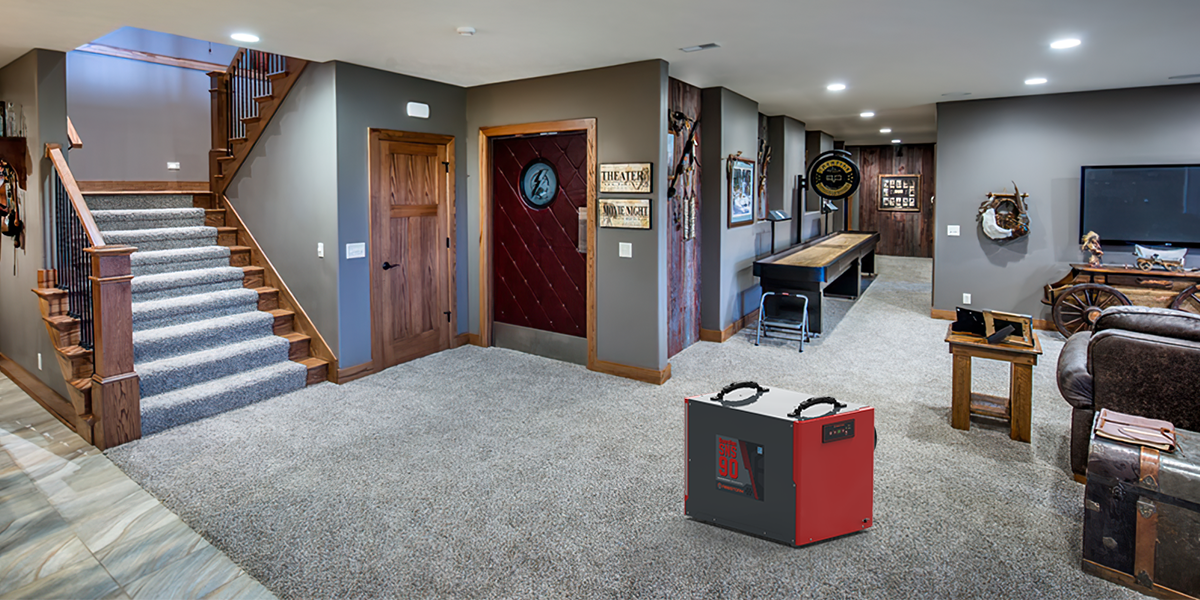Do you think black marks of mold can only appear in the dark, musty basements? You need to think again! Unfortunately, you may see this ugly sight in your kitchen due to various reasons. Mold in the kitchen is a common problem that can pose serious health risks to you and your family. Various studies have shown that there is a close link between mold exposure and the spread of asthma in children. Kitchens are particularly susceptible to mold growth due to the presence of moisture and food sources, which create an ideal environment for mold to thrive.
Addressing mold promptly is crucial for maintaining a healthy home and preventing further damage. Arm your toolkit with Abestorm 550 CFM Filterair HEPA S3 Air Scrubber to ensure the air quality of your house doesn’t become a cause of mold.
"Mold exposure can cause serious health problems, especially for individuals with allergies or respiratory conditions. Identifying and removing mold promptly is essential for a healthy living environment," advises Dr. Laura Bennett, a health and safety expert.
Causes of Mold in the Kitchen
Mold in the kitchen can develop for various reasons, primarily due to the high levels of moisture and the availability of food sources. Here are some common causes:
Leaks: Leaky faucets, pipes, or roofs can introduce water into the kitchen, creating a damp environment where mold can flourish.
Poor Ventilation: Without proper ventilation, steam and moisture from cooking and dishwashing can accumulate, leading to mold growth. You’ll see mold under kitchen cabinets due to this reason.
Spills and Residue: Food spills and residues left uncleaned can provide nutrients for mold.
High Humidity: Kitchens, especially in humid climates, can have high humidity levels, which support mold growth.
Identifying Mold in the Kitchen
Identifying mold in the kitchen is the first step toward effective kitchen mold removal. Mold can appear in various areas, and spotting it early can prevent significant health issues and damage.
Signs of Mold in Kitchen Cabinets
Mold in kitchen cabinets can be hidden and hard to detect. Look for the following signs:
Discoloration: Mold can cause dark or greenish stains on the inside or outside of cabinets.
Musty Odor: A persistent, musty smell coming from your cabinets often indicates mold presence.
Warping or Damage: Wood can warp or deteriorate due to mold growth, affecting the cabinet structure.
At this point, a common question that pops up in the minds is ‘how to get rid of mold in kitchen cabinets’?
Pro Tip: Use a flashlight to inspect hard-to-see areas under your cabinets for any signs of mold under kitchen cabinets.
"Regularly inspect your kitchen cabinets for any signs of mold. Discoloration and a musty odor are clear indicators that mold may be present," advises Dr. Jane Smith.
Signs of Mold in Drawers
Mold in drawers can spread quickly and affect the items stored inside. Here’s what to look for:
Mold Spots: Look for black, green, or white spots inside drawers.
Musty Odor: Drawers with mold often have a musty or earthy smell.
Dampness: Any signs of dampness or water stains can indicate mold growth.
Preparing for Mold Removal
Before you begin the process of kitchen mold removal, it’s essential to prepare adequately to ensure safety and effectiveness.
Safety Precautions
Handling mold can expose you to harmful spores, so taking safety precautions is crucial:
Wear Protective Gear: Always wear gloves, a mask, and safety goggles to protect yourself from mold spores.
Ventilate the Area: Open windows and use fans to ventilate the kitchen while cleaning mold. This helps to reduce mold spore concentration in the air.
Seal Off the Area: Use plastic sheeting and tape to seal off the affected area from the rest of your home to prevent mold spores from spreading.
Soft-Bristle Brush or Sponge: For scrubbing moldy surfaces.
Cleaning Solution: Use a commercial mold cleaner or a homemade solution of water and white vinegar or hydrogen peroxide.
Buckets and Rags: For cleaning and rinsing surfaces.
HEPA Air Scrubber: To remove airborne mold spores and improve air quality.
Pro Tip: An air scrubber can be particularly effective in maintaining indoor air quality during and after the mold removal process.
"Safety should be your top priority when dealing with mold. Proper protective equipment and ventilation are essential to minimize exposure," advises Dr. John Mitchell, an environmental health specialist.
Step-by-Step Kitchen Mold Removal Guide
Removing Mold in Kitchen Cabinets
Here’s a comprehensive guide on how to get rid of mold in kitchen cabinets. Getting rid of mold in kitchen cabinets requires careful attention to detail and the right cleaning methods.
Empty the Cabinets: Remove all items from the cabinets to access the moldy areas.
Vacuum Loose Mold: Use a vacuum with a HEPA filter to remove loose mold spores. Dispose of the vacuum bag or clean the canister immediately after use.
Apply Cleaning Solution: Mix a cleaning solution of water and white vinegar or use a commercial mold cleaner. Apply the solution to the moldy areas using a soft-bristle brush or sponge.
Scrub the Mold: Gently scrub the moldy areas to remove the mold. Be thorough but careful not to damage the cabinet surfaces.
Rinse and Dry: Wipe the cleaned areas with a damp cloth to remove any remaining cleaner. Dry the cabinets thoroughly with a dry cloth or let them air dry in a well-ventilated area.
Disinfect and Seal: Consider using a disinfectant spray and, if necessary, apply a mold-resistant sealant to prevent future growth.
Cleaning Mold in Drawers
Mold in drawers can affect your stored items and spread quickly if not addressed.
Empty the Drawers: Remove all items from the drawers to access the moldy surfaces.
Vacuum Loose Mold: Use a HEPA filter vacuum to remove loose mold spores.
Apply Cleaning Solution: Mix water and white vinegar or use a commercial mold cleaner. Apply the solution to the moldy areas using a sponge or cloth.
Scrub the Mold: Gently scrub the moldy areas to remove the mold without damaging the drawer material.
Rinse and Dry: Wipe the cleaned areas with a damp cloth and dry thoroughly. Leave the drawers open to air dry completely.
Reorganize and Protect: Once dry, place items back into the drawers. Consider using moisture-absorbing packets to prevent future mold growth.
Pro Tip: Regularly check and clean your kitchen drawers to prevent mold from returning.
Using an Air Scrubber for Mold Removal
An Air Scrubber is an effective tool for maintaining indoor air quality during and after kitchen mold removal.
How an Air Scrubber Works
Air Scrubbers use high-efficiency particulate air (HEPA) filters to capture mold spores and other airborne contaminants. The addition of UV light technology can further enhance their effectiveness by killing mold spores and preventing them from spreading.
Benefits of Using an Air Scrubber
With an air scrubber, your house will have an improved air quality. Air Scrubbers continuously clean the air, reducing the concentration of mold spores and other allergens. Moreover, it prevents further mold spread. By capturing airborne spores, Air Scrubbers prevent mold from spreading to other areas of your home. Additionally, it gives you an edge from a health point of view. Cleaner air means fewer health risks for you and your family, particularly those with allergies or respiratory issues.
Preventing Future Mold Growth in the Kitchen
Preventing mold in the kitchen requires ongoing maintenance and vigilance. Here are some tips to keep your kitchen mold-free:
Control Humidity and Ensure Proper Ventilation
Use a Dehumidifier: Keep humidity levels between 30-50% using a dehumidifier.
Ventilation: Ensure your kitchen is well-ventilated. Use exhaust fans during cooking and dishwashing to reduce moisture buildup.
Regular Cleaning and Maintenance
Clean Spills Immediately: Wipe up any spills or leaks immediately to prevent moisture accumulation.
Regular Inspections: Regularly inspect areas prone to mold, such as under sinks, behind appliances, and inside cabinets.
Use Mold-Resistant Products: Consider using mold-resistant paint and materials in your kitchen.
Conclusion
Removing and preventing mold in the kitchen is crucial for maintaining a healthy home environment. By following the steps outlined in this guide, you can effectively tackle mold in kitchen cabinets, under cabinets, and in drawers. Using tools like Air Scrubbers from Abestorm can further enhance your efforts by improving indoor air quality and preventing the spread of mold.
Ready to protect your kitchen from mold?
Visit Abestorm.com to learn more about our Air Scrubbers and other mold removal products. Take advantage of our limited-time discount and expert advice to keep your home mold-free and ensure the health and safety of your family. Invest in a cleaner, healthier kitchen environment today!









Shop For Dehumidifier